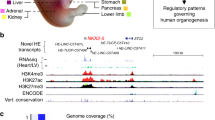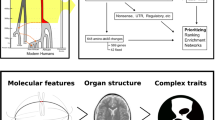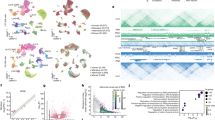Abstract
Copy number variation (CNV) is a key source of genetic diversity, but a comprehensive understanding of its phenotypic effect is only beginning to emerge. We have generated a CNV map in wild mice and classical inbred strains. Genome-wide expression data from six major organs show not only that expression of genes within CNVs tend to correlate with copy number changes, but also that CNVs influence the expression of genes in their vicinity, an effect that extends up to half a megabase. Genes within CNVs show lower expression and more specific spatial expression patterns than genes mapping elsewhere. Our analyses reveal differential constraint on copy number changes of genes expressed in different tissues. Dosage alterations of brain-expressed genes are less frequent than those of other genes and are buffered by tighter transcriptional regulation. Our study provides initial evidence that CNVs shape tissue transcriptomes on a global scale.
This is a preview of subscription content, access via your institution
Access options
Subscribe to this journal
Receive 12 print issues and online access
$209.00 per year
only $17.42 per issue
Buy this article
- Purchase on Springer Link
- Instant access to full article PDF
Prices may be subject to local taxes which are calculated during checkout



Similar content being viewed by others
Accession codes
References
Iafrate, A.J. et al. Detection of large-scale variation in the human genome. Nat. Genet. 36, 949–951 (2004).
Sebat, J. et al. Large-scale copy number polymorphism in the human genome. Science 305, 525–528 (2004).
Korbel, J.O. et al. Paired-end mapping reveals extensive structural variation in the human genome. Science 318, 420–426 (2007).
Kidd, J.M. et al. Mapping and sequencing of structural variation from eight human genomes. Nature 453, 56–64 (2008).
Redon, R. et al. Global variation in copy number in the human genome. Nature 444, 444–454 (2006).
Reymond, A., Henrichsen, C.N., Harewood, L. & Merla, G. Side effects of genome structural changes. Curr. Opin. Genet. Dev. 17, 381–386 (2007).
Eichler, E.E. et al. Completing the map of human genetic variation. Nature 447, 161–165 (2007).
Perry, G.H. et al. Diet and the evolution of human amylase gene copy number variation. Nat. Genet. 39, 1256–1260 (2007).
Stranger, B.E. et al. Relative impact of nucleotide and copy number variation on gene expression phenotypes. Science 315, 848–853 (2007).
Merla, G. et al. Submicroscopic deletion in patients with Williams-Beuren syndrome influences expression levels of the nonhemizygous flanking genes. Am. J. Hum. Genet. 79, 332–341 (2006).
Li, J. et al. Genomic segmental polymorphisms in inbred mouse strains. Nat. Genet. 36, 952–954 (2004).
Adams, D.J. et al. Complex haplotypes, copy number polymorphisms and coding variation in two recently divergent mouse strains. Nat. Genet. 37, 532–536 (2005).
Snijders, A.M. et al. Mapping segmental and sequence variations among laboratory mice using BAC array CGH. Genome Res. 15, 302–311 (2005).
Graubert, T.A. et al. A high-resolution map of segmental DNA copy number variation in the mouse genome. PLoS Genet. 3, e3 (2007).
Egan, C.M., Sridhar, S., Wigler, M. & Hall, I.M. Recurrent DNA copy number variation in the laboratory mouse. Nat. Genet. 39, 1384–1389 (2007).
Cutler, G., Marshall, L.A., Chin, N., Baribault, H. & Kassner, P.D. Significant gene content variation characterizes the genomes of inbred mouse strains. Genome Res. 17, 1743–1754 (2007).
Guryev, V. et al. Distribution and functional impact of DNA copy number variation in the rat. Nat. Genet. 40, 538–545 (2008).
Waterston, R.H. et al. Initial sequencing and comparative analysis of the mouse genome. Nature 420, 520–562 (2002).
Beck, J.A. et al. Genealogies of mouse inbred strains. Nat. Genet. 24, 23–25 (2000).
Frazer, K.A. et al. A sequence-based variation map of 8.27 million SNPs in inbred mouse strains. Nature 448, 1050–1053 (2007).
Yang, H., Bell, T.A., Churchill, G.A. & Pardo-Manuel de Villena, F. On the subspecific origin of the laboratory mouse. Nat. Genet. 39, 1100–1107 (2007).
She, X., Cheng, Z., Zollner, S., Church, D.M. & Eichler, E.E. Mouse segmental duplication and copy number variation. Nat. Genet. 40, 909–914 (2008).
Watkins-Chow, D.E. & Pavan, W.J. Genomic copy number and expression variation within the C57BL/6J inbred mouse strain. Genome Res. 18, 60–66 (2008).
Lee, J.A. et al. Spastic paraplegia type 2 associated with axonal neuropathy and apparent PLP1 position effect. Ann. Neurol. 59, 398–403 (2006).
Gabellini, D., Green, M.R. & Tupler, R. Inappropriate gene activation in FSHD: a repressor complex binds a chromosomal repeat deleted in dystrophic muscle. Cell 110, 339–348 (2002).
Khaitovich, P. et al. Parallel patterns of evolution in the genomes and transcriptomes of humans and chimpanzees. Science 309, 1850–1854 (2005).
Molina, J. et al. Abnormal social behaviors and altered gene expression rates in a mouse model for Potocki-Lupski Syndrome. Hum. Mol. Genet. 17, 2486–2495 (2008).
Chesler, E.J. et al. Complex trait analysis of gene expression uncovers polygenic and pleiotropic networks that modulate nervous system function. Nat. Genet. 37, 233–242 (2005).
Kleinjan, D.J. & van Heyningen, V. Position effect in human genetic disease. Hum. Mol. Genet. 7, 1611–1618 (1998).
Kleinjan, D.A. & van Heyningen, V. Long-range control of gene expression: emerging mechanisms and disruption in disease. Am. J. Hum. Genet. 76, 8–32 (2005).
Gabellini, D. et al. Facioscapulohumeral muscular dystrophy in mice overexpressing FRG1. Nature 439, 973–977 (2006).
Muncke, N. et al. Position effect on PLP1 may cause a subset of Pelizaeus-Merzbacher disease symptoms. J. Med. Genet. 41, e121 (2004).
Fraser, P. & Bickmore, W. Nuclear organization of the genome and the potential for gene regulation. Nature 447, 413–417 (2007).
Heard, E. & Bickmore, W. The ins and outs of gene regulation and chromosome territory organisation. Curr. Opin. Cell Biol. 19, 311–316 (2007).
Denoeud, F. et al. Prominent use of distal 5′ transcription start sites and discovery of a large number of additional exons in ENCODE regions. Genome Res. 17, 746–759 (2007).
Dopman, E.B. & Hartl, D.L. A portrait of copy-number polymorphism in Drosophila melanogaster. Proc. Natl. Acad. Sci. USA 104, 19920–19925 (2007).
Acknowledgements
We thank A. Paillusson, O. Hagenbüchle and K. Harshman from the Lausanne DNA Array Facility for technical help; F. Bonhomme, P. Boursot, J. Gilliéron, S. Maret, A. Orth and M. Tafti for reagents; and S. Deutsch and J. Goudet for suggestions. We are grateful to R.W. Williams for sharing expression data and to the Montpellier wild mice genetic repository and the Museum of Natural History of Geneva for mice and tissue samples. This work was supported by grants from the Jérôme Lejeune Foundation, the Désirée and Niels Yde Foundation, the Novartis Foundation, the Swiss National Science Foundation and the European Commission anEUploidy Integrated Project (grant 037627) to A.R.; by grant NIH R01 GM073822 (PI J. Borevitz) to S.Z.; as well as grants from the European Commission (STREP, PKB140404), EMBO Young Investigator Program and Swiss National Science Foundation to H.K.
Author information
Authors and Affiliations
Contributions
A.R. and H.K. designed and organized the study. Financial support for the generation of the data was obtained by A.R.; C.N.H., E.C. and M.R. prepared the necessary materials and produced the data; and C.N.H., N.V., S.P. and F.S. conducted the statistical analyses guided by H.K. and A.R. The time-dependent hidden Markov method was designed by S.Z. with contributions from N.V. The manuscript was co-written by H.K. and A.R. with contributions from C.N.H., N.V. and S.Z.
Corresponding authors
Supplementary information
Supplementary Text and Figures
Supplementary Note, Supplementary Methods, Supplementary Figures 1–7 and Supplementary Tables 1–5 (PDF 6785 kb)
Supplementary Table 2
Coordinates and aCGH log2 signals of predicted CNVs (XLS 12027 kb)
Supplementary Table 4
Coordinates and validation of predicted CNVs assessed on the high-resolution custom-array (XLS 1534 kb)
Rights and permissions
About this article
Cite this article
Henrichsen, C., Vinckenbosch, N., Zöllner, S. et al. Segmental copy number variation shapes tissue transcriptomes. Nat Genet 41, 424–429 (2009). https://doi.org/10.1038/ng.345
Received:
Accepted:
Published:
Issue Date:
DOI: https://doi.org/10.1038/ng.345
This article is cited by
-
Copy Number Variation and Expression Dynamics of the Dominant Vernalization-A1a Allele in Wheat
Plant Molecular Biology Reporter (2024)
-
A genome-wide survey of copy number variations reveals an asymmetric evolution of duplicated genes in rice
BMC Biology (2020)
-
Sensitivity to gene dosage and gene expression affects genes with copy number variants observed among neuropsychiatric diseases
BMC Medical Genomics (2020)
-
Transcriptional effects of copy number alterations in a large set of human cancers
Nature Communications (2020)
-
Copy number variation profiling in pharmacogenes using panel-based exome resequencing and correlation to human liver expression
Human Genetics (2020)



